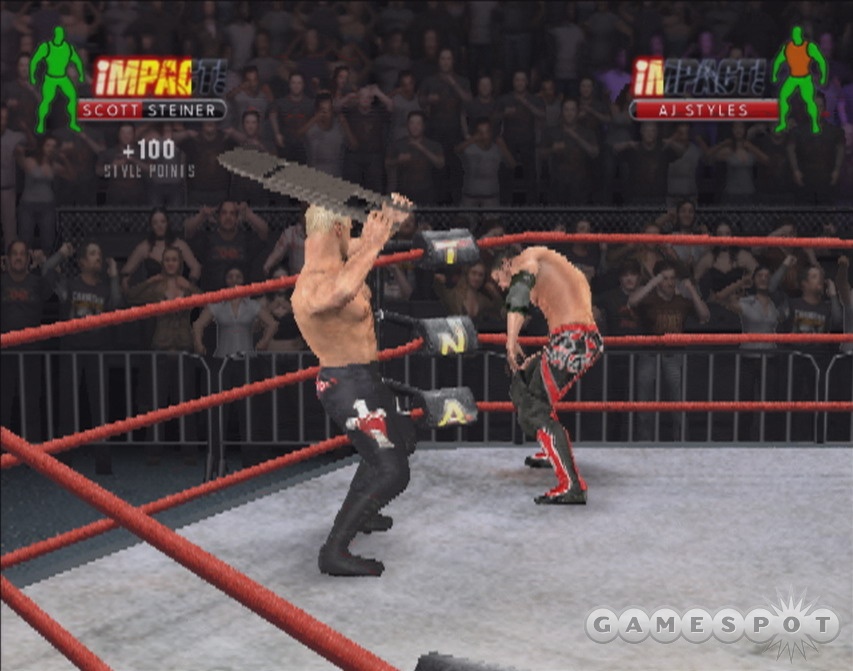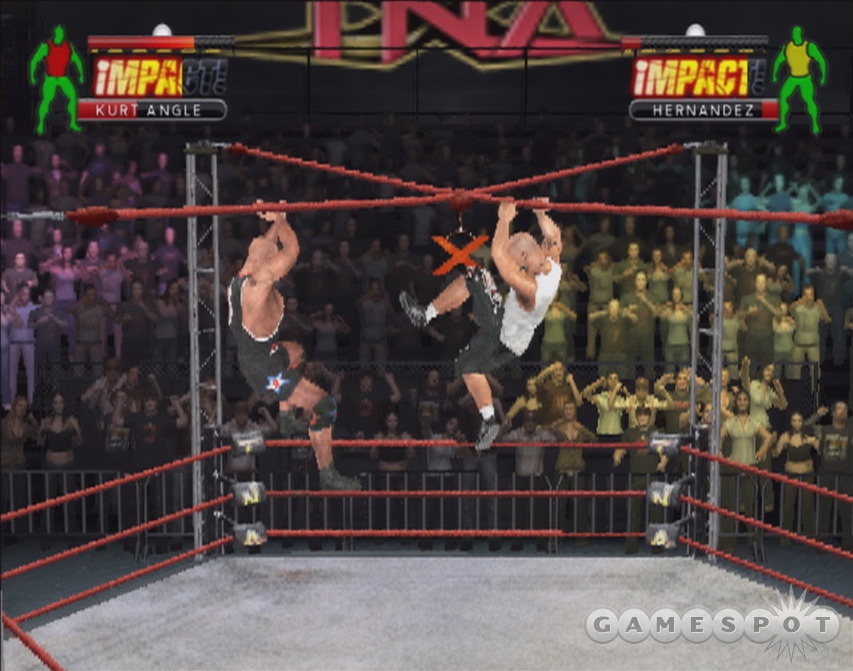Professional wrestling has long been maligned as a place where spandex-clad ogre-men go to act out contrived rivalries and pretend to actually wrestle. While these derisions certainly hit on some truths about "sports entertainment," the remarkable talents and impressive athleticism of its practitioners cannot be denied. If you're the kind of person who enjoys the high-flying, hard-hitting spectacle of pro wrestling in spite of its myriad absurdities, then TNA Impact may be the game for you. It has some aggravating problems, but it does a good job of translating the excitement of TNA Wrestling into fluid action and visceral fun.
A wrestling game is only as fun as the moves you can perform, and in this regard, TNA Impact does quite well. You ratchet up your basic punch and kick attacks by holding the strong modifier or by performing them from a run or in a grapple. This simple layering allows for a wide range of moves without requiring complex button combinations, so it's easy to unleash your nastiest attacks right from the get-go. You can also reverse almost any attack with a well-timed button press, and many reversals can be reversed again. The accessible variety of attacks and the ever-looming possibility of reversals make the action fast and furious.

The more you mix up your moves, the more likely you are to come across some of the game's many technical hitches. When the animations run smoothly, they look good and produce satisfying impacts. When they don't quite line up, you see fists and feet clipping through torsos, as well as apparent misses registering as hits. These oddities are a minor distraction, though, because at least you are still performing the moves you want. The more frustrating glitches cause your character to perform an unintended maneuver, often with disastrous results.
The glitches are prone to surface in a few situations, the most frequent of which are transitions, such as when your character is getting up off the mat, climbing a turnbuckle, or exiting the ring. Because your attack changes depending on your opponent's position, you may often find yourself aiming to punch an enemy as soon as he stands up, only to execute an elbow drop and lay yourself out at his stomp-happy feet. You can also dodge grapples or attacks when you're near the edge of the ring because the animation of rolling out of the ring will often negate incoming moves. Then, there's the particularly tricky situation when your opponent is down near the edge of the ring. Climbing up on the turnbuckle, rolling out of the ring, and pinning an opponent are all mapped to the same button, which makes it very difficult to figure out how to position yourself to execute the action you want. In this case, you're better off avoiding those three actions altogether.
When you're playing against other human players, these hang-ups don't feel so frustrating because you are all subject to the same pitfalls. In the single-player Story mode you can suffer a few miscues and still scrape out a win a win early on. You'll hit a wall when the foes get tougher, though, because the room for error diminishes so much so that a missed move or missed opportunity can cost you the match. This is vexing enough when it's an honest mistake, but it becomes downright infuriating when it's an animation glitch.
The punishing difficulty in the latter part of the Story mode isn't its only weak point. The voice acting feels flat in contrast with the vigorous banter featured on the actual show, and the actor who voices your character is just terrible, dragging every other character down with his lifeless tone (the closest thing you'll find to personality is in the training videos featured in the extras menu). The only incentive to play the Story mode is to unlock new characters and arenas. With each victory, you earn style points, and the more various and risky your moves are, the more points you'll earn. Unlike in the PlayStation 3 and Xbox 360 versions, these points don't actually appear to earn you anything, given that you don't actually customize your character or move set. As if to compensate for the puzzling lack of character creation, there are a lot more unlockable wrestlers in the PlayStation 2 version, though many of them are no-name goons.

Multiplayer is the best way to enjoy TNA Impact, and there's a full array of match types available. One-on-one matches, three-way free-for-alls, tag-team brawls, handicap contests, and the signature Ultimate X matches are all playable, though only two players can actually compete at a time. Ultimate X matches, while dramatic on television, often feel less exciting than normal matches because the focus becomes staying aloft on the cables rather than pummeling your opponents. There's nothing unexciting about that per se, but the hanging combat is awkward and limited. Actually grabbing the X also requires you to tap a button when a moving cursor lines up with a target area--an action that could be diplomatically described as "anticlimactic."
So, TNA Impact is not without its flaws. The character models are good, and the animation is fluid and lively, but the unpolished physics of fighting can create some frustrating situations, and the lo-fi audio often sounds flat. Yet despite these technical shortcomings (and silly costumes), it's still good fun to clothesline, drop-kick, and power-bomb your friends all around the ring. And, ultimately, isn't that what pro wrestling is all about?